oxygen
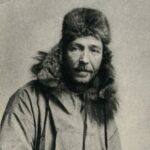
 As a hiker, I can relate to the draw of a mountain peak, but I was never one to do the winter-ice-climbing-up-a-solid-rock-face type of hiker. I like trail hiking personally, but there are many people who would disagree with me on that. One such hiker/climber was Hudson Stuck, an Alaskan missionary, who on June 7, 1913, led the first successful ascent of Denali…also known as Mount McKinley, before they changed the name. Denali, at 20,320 feet is the highest on the American continent. In fact, there are planes that don’t fly that high…small planes, but nevertheless, they don’t go that high, and would have to fly around Denali.
As a hiker, I can relate to the draw of a mountain peak, but I was never one to do the winter-ice-climbing-up-a-solid-rock-face type of hiker. I like trail hiking personally, but there are many people who would disagree with me on that. One such hiker/climber was Hudson Stuck, an Alaskan missionary, who on June 7, 1913, led the first successful ascent of Denali…also known as Mount McKinley, before they changed the name. Denali, at 20,320 feet is the highest on the American continent. In fact, there are planes that don’t fly that high…small planes, but nevertheless, they don’t go that high, and would have to fly around Denali.
Not crazy enough to try Denali solo, Stuck recruited Harry Karstens, a respected guide, to join his expedition as co-leader. Other members were Walter Harper and Robert G Tatum, both 21, and two student volunteers from the mission school, John Fredson and Esaias George. They departed from Nenana on March 17, 1913. They reached the summit of Denali on June 7, 1913…nearly three months later. Harper, who was of mixed Alaska Native and Scots descent, reached the summit first. Fredson, who was just 14, acted as their base camp manager, hunting caribou and Dall sheep to keep them supplied with food.
There is snow on the mountain year-round, and the air up there is thin, requiring some climbers to bring oxygen. Experienced climbers might be able to climb Denali without oxygen, but sometimes, no matter how fit the body, it can fall victim to the effects of low oxygen…fatigue, hyperventilation, fainting, or worse. So, whether it is needed or not, oxygen is a good idea to have on the trek.
Stuck, who was born in London on November 4, 1863, is an accomplished amateur mountaineer. Mountain climbing, like hiking is an addictive passion, once it takes hold of a person. The feeling you get when you are out there, pushing yourself to new heights or longer hikes, simply can’t be matched in any gym. After moving to the United States, in 1905 Stuck became archdeacon of the Episcopal Church in Yukon, Alaska. His treks across Alaska’s difficult terrain were to preach to villagers and establish schools. His climbing of Denali was more a personal goal than a church oriented one. Stuck was an adventure-seeker, and it was that spirit that drove him to higher heights in every area of his life. And it was that spirit that drove him to the mountain tops…maybe to worship God there too. He was a missionary, after all.
Mount McKinley National Park was established as a wildlife refuge in 1917. Harry Karstens served as the park’s first superintendent. In 1980, the park was expanded and renamed Denali National Park and Preserve. 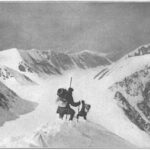
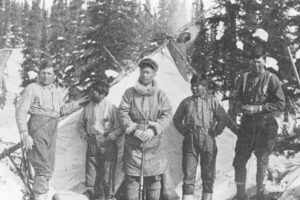 Encompassing 6 million acres, the park is larger than Massachusetts. In 2015, the mountain was officially renamed Denali. Hudson Stuck died of bronchial pneumonia at Fort Yukon, in his beloved Alaska on October 10, 1920. He was 56 years old. At his request, Stuck, still a British citizen is buried in the local cemetery at Fort Yukon. Today, over 1,000 hopeful climbers attempt to scale Denali each year, with about half of them successfully reaching their goal.
Encompassing 6 million acres, the park is larger than Massachusetts. In 2015, the mountain was officially renamed Denali. Hudson Stuck died of bronchial pneumonia at Fort Yukon, in his beloved Alaska on October 10, 1920. He was 56 years old. At his request, Stuck, still a British citizen is buried in the local cemetery at Fort Yukon. Today, over 1,000 hopeful climbers attempt to scale Denali each year, with about half of them successfully reaching their goal.
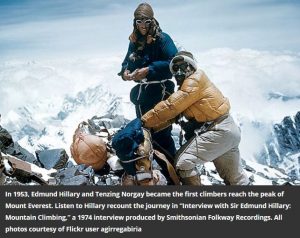 The news of June 2, 1953 was of Queen Elizabeth II’s coronation, but also of the hailed “good omen” for their country’s future…in reference to the first explorers to reach the summit of Mount Everest, which at 29,035 feet above sea level is the highest point on earth. The landmark assent to the top of the world culminated at 11:30am on May 29, 1953 when Edmund Hillary of New Zealand and Tenzing Norgay, a Sherpa of Nepal, made their final assault on the summit after spending a fitful night at 27,900 feet.
The news of June 2, 1953 was of Queen Elizabeth II’s coronation, but also of the hailed “good omen” for their country’s future…in reference to the first explorers to reach the summit of Mount Everest, which at 29,035 feet above sea level is the highest point on earth. The landmark assent to the top of the world culminated at 11:30am on May 29, 1953 when Edmund Hillary of New Zealand and Tenzing Norgay, a Sherpa of Nepal, made their final assault on the summit after spending a fitful night at 27,900 feet.
While the first summit of Mount Everest was an epic accomplishment, it was the words “fitful night” that drew my attention the most. I recently finished a novel by Harry Farthing called “Summit.” While his book was a novel, much of it was based on, if not actual events, actual conditions on the mountain. I am a hiker, and I like hiking to the highest mountains in an area, but let it be known that I am not a mountain climber, and I have no desire to hike through treacherous snow storms to reach the victory of the summit. Nevertheless, many people are obsessed with getting to the world’s highest peaks. Such was the case with Hillary and Norgay. They were determined to make it. I have no idea how prepared they were, but since their victory, and quite possibly before it too, there have been those who misjudged the mountain, the storms, and their own abilities…to their detriment.
While listening to “Summit,” I found myself cheering on the climbers, but also feeling the depths of the many defeats along the way. The biggest necessity on the mountain, is oxygen. At the base camp of Mount Everest, which is 17,500 feet, the air contains 50% of oxygen levels at sea level. At that level, without oxygen, people feel tired and light-headed and develop a headache. They might feel nauseous and even begin to vomit up everything they eat, and then just dry heave themselves to exhaustion. Of course, having oxygen tanks can change this situation into one that is manageable for survival. And that is just at the base camp, which is almost 12,000 feet below the summit. Between Camp 1, at 20,000 feet, and Camp 3, at 24,000 the oxygen levels drop to below 40%. At this point you are prone to hallucinate. Your whole body hurts. You can’t eat, sleep, and most people find breathing next to impossible. From here you operate on sheer willpower. You put one foot in front of the other, and keep moving, because if you do not, you will die. As you near the summit, at 29,035 feet, the air has less that one-third of the sea level oxygen, and can drop as low as 14%…a low level that was recorded in 1996. Twenty climbers lost their fight with the mountain, and their lives, that year. At this point, you should for all intents and purposes be dead. If you are still going, you are probably one of just a few people. On May 8, 1978, Reinhold Messner and Peter Habeler reached the summit of Mount Everest. They were the first men known to climb it without the use of supplemental oxygen. Two years later, on August 20, 1980, Messner again stood atop the highest mountain in the world, without supplementary oxygen. Cory Richards and Adrian Ballinger also summited the highest mountain in the world in 2017…Ballinger without supplemental oxygen. I don’t know how they did it. Those who have failed to make it to the summit, with or without oxygen, have said that they now know what dying feels like. I’m sure that doesn’t apply to all kinds of death, but certainly death on Mount Everest or any of the other mountains that are nearly as tall, it is like this. The symptoms of death by oxygen depravation quickly take their toll on the body. In the minutes before death, the pain must be excruciating. And then, still before death arrives, the body gives up, and feels no more. The 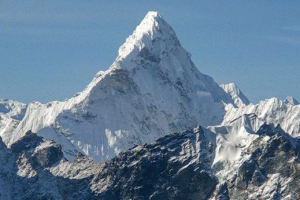 people that die on Everest are left on Everest. They climbers that go up, pass them along the way. It is a grim reminder that if you are not prepared, you might not be coming down.
people that die on Everest are left on Everest. They climbers that go up, pass them along the way. It is a grim reminder that if you are not prepared, you might not be coming down.
Mount Everest sits on the crest of the Great Himalayas in Asia, lying on the border between Nepal and Tibet. Called Chomo-Lungma, or “Mother Goddess of the Land,” by the Tibetans, the English named the mountain after Sir George Everest, a 19th-century British surveyor of South Asia. It is a majestic mountain, and one I might enjoy seeing…from an airplane…but it is not one that I would ever choose to climb, even though I love to hike. Nevertheless, you can’t help be to be in awe of those who would climb the mountain and receive that treacherous victory.
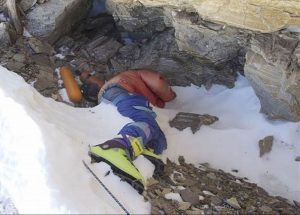 I love to hike, but that does not include going to the highest peak I can find. Don’t get me wrong, because I have hiked to the top of some mountains. They just weren’t on the level of Everest or K2. While I love to challenge myself by hiking up some pretty big mountains, I’m just not interested in taking on the ones where the air is so thin that you need oxygen, and the snow never melts. There are, nevertheless, people who feel the challenge to ascend to the highest peaks in the world. They throw caution to the wind, to go where few people have ever gone before. Believe me, I admire their tenacity, but that is simply not a goal I have, or ever will set, for myself.
I love to hike, but that does not include going to the highest peak I can find. Don’t get me wrong, because I have hiked to the top of some mountains. They just weren’t on the level of Everest or K2. While I love to challenge myself by hiking up some pretty big mountains, I’m just not interested in taking on the ones where the air is so thin that you need oxygen, and the snow never melts. There are, nevertheless, people who feel the challenge to ascend to the highest peaks in the world. They throw caution to the wind, to go where few people have ever gone before. Believe me, I admire their tenacity, but that is simply not a goal I have, or ever will set, for myself.
Mount Everest is a very unforgiving mountain. In the years that people have been climbing it, there have been over 200 deaths on it slopes. These were experienced climbers who knew what they were up against, and yet, the elements and the lack of breathable oxygen, beat them in the end. Of those 200+ people who lost their lives to Everest, many are still up on the slopes, right where they fell. They didn’t get off the beaten paths, they just didn’t get back down quickly enough, and now their bodies serve as a grim reminder of the harsh reality that is Everest. These people might have truly believed that they could make it, and many of them had no idea that they were dying. Severe cold and lack of oxygen will do that to a person.
In a gruesome ritual, each new climber who takes the challenge and starts up the mountain, must pass by the unfortunate ones who didn’t make it back down. To me, the bodies would serve as a warning to turn around and go back down, now…to use my head and stay alive, rather than my ambition to succeed at something that, to most of us, seems insane. I know that there are people who would disagree, believing that challenge is worth the risk, and it might be, right up to the point when you realize that you are about to become a statistic of Mount Everest. Of course, by the time you realize that, it is too late.
Mount Everest, located some 186 miles north-east of Kathmandu, holds the impressive title of tallest mountain in the world, but many people don’t know about its other, more gruesome title…the world’s largest open-air graveyard. Edmund Hillary and Tenzing Norgay first scaled the summit in 1953. Since then, over 4,000 people have followed in their footsteps, braving the harsh climate and dangerous terrain in the hope of a few moments of glory. Unfortunately, some of them never left the mountain. The top portion of the mountain, roughly everything above 26,000 feet, is known as the “death zone.” In the “death zone” the oxygen levels are only at a third of what they are at sea level, and the barometric pressure causes weight to feel ten times heavier. The combination of those two factors makes climbers feel sluggish, disoriented and fatigued…and can cause extreme stress on organs. For this reason, climbers don’t usually last more than 48 hours in this area.
The climbers that overstay their safety window are usually left with lasting effects. The ones that don’t make it out are left where they fall…it’s standard protocol, unfortunately, and so these corpses remain to spend eternity on the mountaintop, serving as a warning to climbers as well as gruesome mile markers. Each climber who attempts Mount Everest knows the possibilities. One of the most famous corpses, known as “Green Boots” was passed by almost every climber to reach the death zone. The identity of Green Boots while highly contested, is believed to be Tsewang Paljor, an Indian climber who died in 1996. Before the body’s recent removal, Green Boot’s body rested near a cave that all climbers must pass on their way to the peak. The body became a grim landmark used to gauge how close one is to the summit. He is famous for his green boots. According to one seasoned adventurer “about 80% of people also take a rest at the shelter where Green Boots is, and it’s hard  to miss the person lying there.” “Green Boots” is known as such because of the neon boots he was wearing when he died.
to miss the person lying there.” “Green Boots” is known as such because of the neon boots he was wearing when he died.
In 2006 another climber joined in Green Boots in his cave, sitting, arms around his knees in the corner, forever. David Sharp was attempting to summit Everest on his own, which is never advisable. Even the most advanced climbers would warn against it. He had stopped to rest in Green Boots’ cave, as so many had done before him. Over the course of several hours, he froze to death, his body stuck in a huddled position, just feet from one of the most famous Mount Everest bodies. Green Boots most likely died unnoticed, due to the small amount of people hiking at that time, but at least 40 people passed by Sharp that day. Incredibly, not one of them stopped. Sharpe’s death sparked a moral debate about the culture of Everest climbers. Though many had passed by Sharp as he lay dying, and their eyewitness accounts claim he was visibly alive and in distress, no one offered their help. How could they even live with themselves after that?
Sir Edmund Hillary, the first man to ever summit the mountain, criticized the climbers who had passed by Sharp and attributed it to the mind-numbing desire to reach the top. “If you have someone who is in great need and you are still strong and energetic, then you have a duty, really, to give all you can to get the man down and getting to the summit becomes very secondary,” he told the New Zealand Herald, after news of Sharp’s death broke. “I think the whole attitude towards climbing Mount Everest has become rather horrifying,” he added. “The people just want to get to the top. They don’t give a damn for anybody else who may be in distress and it doesn’t impress me at all that they leave someone lying under a rock to die.” The media termed this phenomenon “summit fever,” and it’s happened more times than most people realize.
In 1999, the oldest known body was found on Everest. George Mallory’s body was found 75 years after his 1924 death after an unusually warm spring. Mallory had attempted to be the first person to climb Everest, though he had disappeared before it could be found out if he had achieved his goal.
His body was found in 1999, his upper torso, half of his legs, and his left arm almost perfectly preserved. He was dressed in a tweed suit and surrounded by primitive climbing equipment and heavy oxygen bottles. He had a rope injury around his waist, which led those who found him to believe he had been roped to another climber when he fell from the side of a cliff. The fate of the other climber is unknown, and no one knows if Mallory made it to the top, so the title of “the first man to climb Everest” was given to someone else. Though he may not have made it, rumors of Mallory’s climb had swirled for years, leading many to wonder. He was a famous mountaineer at the time and when asked why he wanted to climb the then unconquered mountain, he famously replied, “Because it’s there.”
One of the most horrifying sights on Mount Everest is the body of Hannelore Schmatz. In 1979, Schmatz became not only the first German citizen to perish on the mountain but also the first woman. Schmatz had actually reached her goal of summiting the mountain, before ultimately succumbing to exhaustion on the way down. Her Sherpa’s warned her not to set up camp in the “death zone,” but she did anyway. She managed to survive a snowstorm hitting overnight, and made it almost the rest of the way down to camp before a lack of oxygen and frostbite resulted in her giving into exhaustion. This poor woman fell just 330 feet from base camp. That is a devastating loss…so close and yet too far. Her body remains on the mountain, extremely well preserved due to the consistently below zero temperatures. For a long time, her body remained in plain view of the mountain’s Southern Route, leaning against a long deteriorated backpack with her eyes open and her hair blowing in the wind. Then, 70-80 mph winds either blew a covering of snow over her or pushed her off the mountain. Her final resting place is currently unknown.
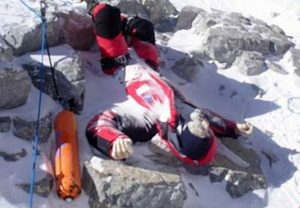 It’s due to the same things that kill these climbers that recovery of their bodies can’t take place. To us that seems insane, but when someone dies on Everest, especially in the death zone, it is almost impossible to retrieve the body. The weather conditions, the terrain, and the lack of oxygen makes it difficult to get to the bodies. Even if they can be found, they are usually stuck to the ground, frozen in place. In fact, two rescuers died while trying to recover Schmatz’s body and countless others have perished while trying to reach the rest. Despite those risks, and the bodies they know they will encounter, thousands of people still flock to Everest every year to attempt one of the most impressive, if not insane, feats known to man today.
It’s due to the same things that kill these climbers that recovery of their bodies can’t take place. To us that seems insane, but when someone dies on Everest, especially in the death zone, it is almost impossible to retrieve the body. The weather conditions, the terrain, and the lack of oxygen makes it difficult to get to the bodies. Even if they can be found, they are usually stuck to the ground, frozen in place. In fact, two rescuers died while trying to recover Schmatz’s body and countless others have perished while trying to reach the rest. Despite those risks, and the bodies they know they will encounter, thousands of people still flock to Everest every year to attempt one of the most impressive, if not insane, feats known to man today.
 I think a lot of us have thought about just getting away from it all for a while. Life gets too busy, and we just think that if we could have a little time away, with nowhere in particular to be at any given time, we could come out of that stressful sort of funk we find ourselves in. Now I don’t know if that was what medical doctor and researcher, Roy Walford, along with Jane Poynter, Taber MacCallum, Mark Nelson, Sally Silverstone, Abigail Alling, Mark Van Thillo, and Linda Leigh had in mind or not when, on September 26, 1991, they entered a facility called Biosphere 2, for a two year stay inside…without leaving, but that is what they did. Granted, they weren’t alone in the facility, but they were there for two full years, finally emerging again on September 26, 1993.
I think a lot of us have thought about just getting away from it all for a while. Life gets too busy, and we just think that if we could have a little time away, with nowhere in particular to be at any given time, we could come out of that stressful sort of funk we find ourselves in. Now I don’t know if that was what medical doctor and researcher, Roy Walford, along with Jane Poynter, Taber MacCallum, Mark Nelson, Sally Silverstone, Abigail Alling, Mark Van Thillo, and Linda Leigh had in mind or not when, on September 26, 1991, they entered a facility called Biosphere 2, for a two year stay inside…without leaving, but that is what they did. Granted, they weren’t alone in the facility, but they were there for two full years, finally emerging again on September 26, 1993.
Biosphere 2 is an agricultural system that produced 83% of the total diet, which included crops of bananas, papayas, sweet potatoes, beets, peanuts, lablab and cowpea beans, rice, and wheat. No toxic chemicals could  be used, because they would impact health. That first year was tough. The eight inhabitants were continually hungry. Things got better in the second year, when they produced over a ton more food. They were eating more and so regained some of the weight lost during the first year. They took with them, domestic animals for the agricultural area during the first mission, including four pygmy goats and one billy goat from the plateau region of Nigeria, 35 hens and three roosters a mix of Indian jungle fowl (Gallus, Japanese silky bantam, and a hybrid of these), two sows and one boar pig, as well as tilapia fish grown in a rice and azolla pond system originating long ago in China. These were designed to round out the diet. There was public excitement, as well as doubt, especially when an injured member was allowed to leave and return, bringing in plastic bags. The public thought it was food. In the end, I’m not sure if they deemed the project a success or not. I suppose it would depend on who you talked to. The system could not produce enough oxygen so that had to be pumped in. Also, some of the species died, and some of the dead fish clogged the filtration system.
be used, because they would impact health. That first year was tough. The eight inhabitants were continually hungry. Things got better in the second year, when they produced over a ton more food. They were eating more and so regained some of the weight lost during the first year. They took with them, domestic animals for the agricultural area during the first mission, including four pygmy goats and one billy goat from the plateau region of Nigeria, 35 hens and three roosters a mix of Indian jungle fowl (Gallus, Japanese silky bantam, and a hybrid of these), two sows and one boar pig, as well as tilapia fish grown in a rice and azolla pond system originating long ago in China. These were designed to round out the diet. There was public excitement, as well as doubt, especially when an injured member was allowed to leave and return, bringing in plastic bags. The public thought it was food. In the end, I’m not sure if they deemed the project a success or not. I suppose it would depend on who you talked to. The system could not produce enough oxygen so that had to be pumped in. Also, some of the species died, and some of the dead fish clogged the filtration system.
 The eight members of the team survived, so I suppose that would be considered a success, and they did stay the full two years that had been planned. It was an interesting experiment I’m sure, and it would be a definite getaway from normal, everyday life, but I’m sure it had it’s downside too. Not being able to be with your family, seeing only the facility, and eating the same food, day in and day out, just to name a few. Personally, I think that two years might be a little bit of a long getaway…in fact, I think I would probably go just a little bit stir crazy…or maybe a lot stir crazy. The second experiment didn’t go so well, with a number of problems precipitating the premature exit of the team. Maybe they went stir crazy too.
The eight members of the team survived, so I suppose that would be considered a success, and they did stay the full two years that had been planned. It was an interesting experiment I’m sure, and it would be a definite getaway from normal, everyday life, but I’m sure it had it’s downside too. Not being able to be with your family, seeing only the facility, and eating the same food, day in and day out, just to name a few. Personally, I think that two years might be a little bit of a long getaway…in fact, I think I would probably go just a little bit stir crazy…or maybe a lot stir crazy. The second experiment didn’t go so well, with a number of problems precipitating the premature exit of the team. Maybe they went stir crazy too.
 By the late 1960s, space travel had become a pretty common story for the people of the United States. NASA had enjoyed a relatively accident free space travel history, having only lost three astronauts, and that was a fire on the launch pad during training. So, when it came to Apollo 13 going to the Moon, which had been done twice before, the networks decided that it was boring, and opted not to televise the program…until disaster changed everything. For me, it seems impossible that anyone could think that space flight is boring, but someone at the top ranking position in the media, had made an executive decision, so that was the end of it.
By the late 1960s, space travel had become a pretty common story for the people of the United States. NASA had enjoyed a relatively accident free space travel history, having only lost three astronauts, and that was a fire on the launch pad during training. So, when it came to Apollo 13 going to the Moon, which had been done twice before, the networks decided that it was boring, and opted not to televise the program…until disaster changed everything. For me, it seems impossible that anyone could think that space flight is boring, but someone at the top ranking position in the media, had made an executive decision, so that was the end of it.
On April 11, 1970, Apollo 13, the third manned lunar landing mission was launched from Cape Canaveral, Florida, carrying astronauts Jim Lovell, Jack Swigert, and Fred Haise. If you’ve ever seen the movie “Apollo 13”, you will know that Jack Swigert had replaced Ken Mattingly, who had been exposed to the German measles. Ken would never get the measles, but rather was a part of the NASA team effort that worked to bring the stranded astronauts back home safely. The crew planned to land on the Fra Mauro highlands of the moon, but two days into the mission, disaster struck when oxygen tank number 2 blew up in the spacecraft, after Jack Swigert was told to preform a cryo stir procedure to the oxygen tanks…a routine maintenance procedure. Then, Swigert uttered those now famous words, “Houston, we’ve had a problem here.” After evaluation, it was determined that the normal supply of oxygen, electricity, light, and water had been disrupted. Their mission to land on the Moon was over, and now they had a new mission…survival!!
Suddenly the news media was very interested in this mission. A successful mission was boring and not news worthy at all, but one in which fatalities might occur, is very interesting. Sad really…when you think about it. The television stations were supposed to broadcast a segment the crew did about life in space, but while the crew did their segment, the stations decided not to broadcast it for lack of interest. Nine minutes later, when disaster struck, everyone was suddenly very interested. I guess I just don’t understand why we would rather watch news about a disaster, than a successful space mission. I don’t think there is anything common about space travel, and yet, it goes on a lot in our world, completely without notice.
Once the disaster began, the world watched anxiously, praying for the safe return of these brave men. The broken vehicle could not make the trip, and they would have to use the lunar landing module, Oddesy to get them home. They limped along, making the necessary “MacGyver” like connections and adjustments to allow them to have enough oxygen. They made “controlled burns” using the Earth as a guide. Not very controlled at all. It took tremendous effort on the parts of many people, but it all paid off, when on April 17, tragedy turned to triumph as the Apollo 13 astronauts touched down safely in the Pacific Ocean. It was a successful failure, in that no lives were lost.

